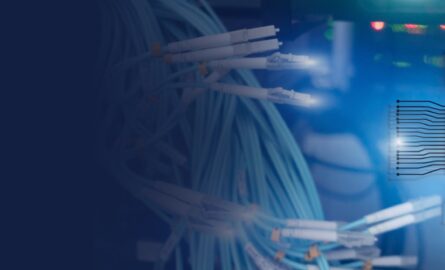With the introduction of new telecom and Internet offerings, such as video streaming, social networking, augmented reality and virtual desktops, end-user access bandwidth has significantly increased. To deliver these services, providers have heavily invested into specially constructed equipment that was rolled out in their central offices. However, they promptly realized that this mode of operation was unsustainable, resulting in increased OPEX and slow time-to-market. To address these challenges, the majority of companies have already been on their way to moving the network function from expensive purpose-built hardware to software that can be run in a virtualized form. CORD is the technology that drives this transformation.
Are central offices becoming obsolete?
Just as a quick reminder, central offices, or exchanges, are buildings where service providers store their switching equipment to deliver telecommunication services to their end users. These gray, windowless concrete buildings are similar all over the world and can be schematically displayed as follows:
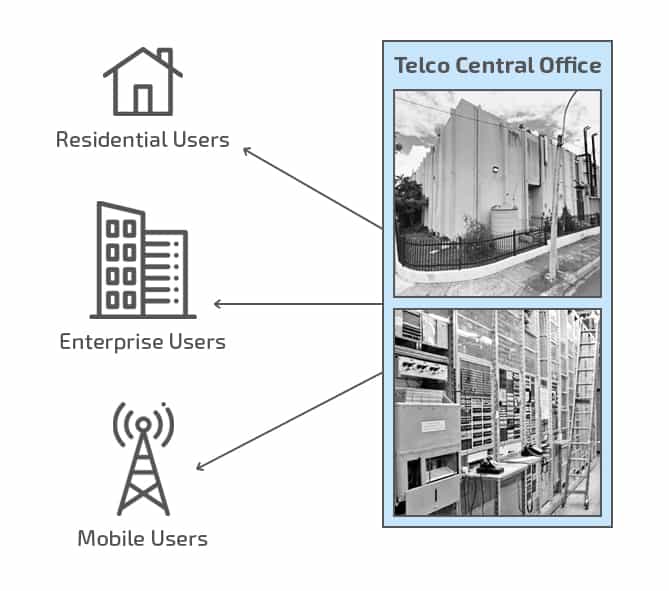
Every service provider has thousands of them spread across the country and has been investing for years in maintaining and upgrading their costly equipment, which, for the record, differs depending on the type of network supported (mobile, residential, enterprise etc.). Therefore, if a provider decides to introduce a new service or function, all the hardware appliances in all the switching facilities throughout the region should be upgraded, which can take months or sometimes even years. Each piece of equipment, in addition, has its own maintenance lifecycle, which makes the overall upgrade a tedious planning exercise. The impact on service providers in this case is obvious: high expenses, long processes, and slow time to market. According to S&P Capital IQ [1] and McKinsey & Company analysis, the cash flows of telephone companies dropped steadily by an average of 6% per year since 2010, and their capital expenditures hovered at around 15% of revenues for a decade [2].
To overcome these obstacles, service providers have started to deliver their services from centralized data centers, leveraging Network Functions Virtualization (NFV) and Software Defined Networking (SDN) to replace functions performed by physical hardware with virtualized software applications.
The second life of telephone exchanges
NFV and SDN are not just marketing buzzwords, they are a technological reality. According to John Donovan, senior executive vice president at AT&T Technology and Operations, the world’s largest telecommunications company, they are on track to virtualize 75% of their entire global network by 2020 [3]. “The traditional hardware approach is too slow,” Donovan said. “The only way to stay ahead of the demand curve is software.”
However, let us imagine for a moment what implications this network virtualization will have for the countless central offices from where telco services are traditionally delivered. As major telecommunication companies transform their network infrastructure to make it more agile through software, most of their telephone switching centers will probably look less like typical central offices and more like data centers.
Data centers’ layered architecture provides flexibility in quick deployment and support of new services, which results in a significant competitive advantage for service providers. Does it mean that switching equipment from central offices is to be literally replaced with server racks? Well, partially yes. Therefore, the companies are looking for the most effective and low-cost ways to conduct this migration. One of them is replacing rooms full of servers with a cloud connection. That is where CORD comes in.
The next generation of Telco infrastructure
CORD (Central Office Re-architected as Data Center) is an open-source solution platform, enabling service providers to bring data center economics of scale and cloud agility to their central offices. One of the main advantages of this approach is its applicability to various types of networks, such as residential, enterprise, and mobile, leveraging a common hardware and software infrastructure:
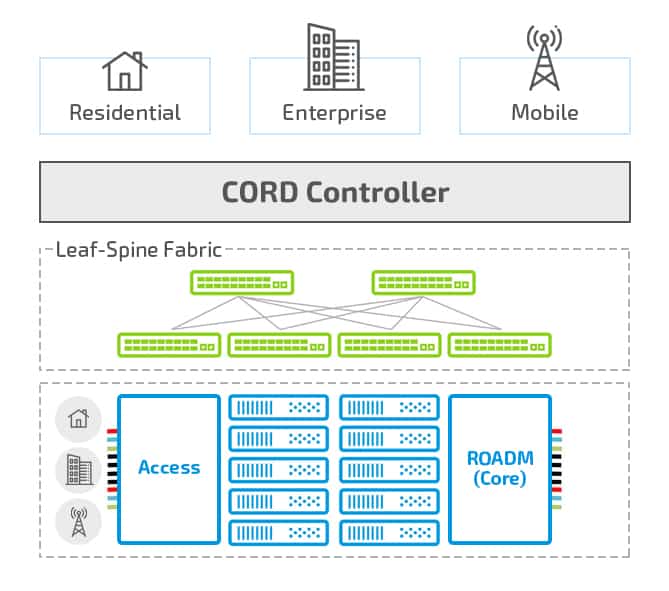
The objective of CORD is not only to replace expensive custom-built hardware with more sustainable and agile software-based counterparts, but also to convert central offices to integral parts of service provider’s complex cloud strategy, enabling them to offer more valuable and user-specific services. For that purpose, CORD integrates the following three technology trends, each with its own role in reducing costs and driving innovation:
- SDN, which is about separating the network’s control and data plane, enabling the control plane programmability. This results in network infrastructure simplification, allowing providers to use inexpensive white-box switches that can be built using merchant silicon.
- NFV, which is about moving network services running on dedicated hardware to virtual machines running on commodity servers. This reduces CAPEX through replacing high-margin devices with affordable hardware and OPEX through agile software-based orchestration.
- The Cloud, which is about building scalable services, utilizing software-based solutions, virtualized commodity platforms and micro-service architecture. This enables service providers to innovate rapidly.
While it is obvious that the technologies listed above are sources of new features and revenue streams, by unifying them CORD goes beyond what each one offers separately. On control plane level, apart from network infrastructure streamlining, it implements SDN to deliver new services, such as content-centric networking or cloud-network binding. On data plane level, it not only supports legacy network functions in virtual machines, but also disaggregates functionality into detailed elements. And, in addition to supporting traditional scalable cloud services (SaaS), CORD extends the cloud paradigm, enabling operators to provide access as a service.
The architecture of CORD
The hardware behind CORD consists of a set of commodity servers and storage units, interconnected by a leaf-spine fabric constructed from white-box switches, which directs east-to-west traffic flow between customer access network and upstream network connections. There is no north-south traffic flow in the conventional sense.
Edge Access units (GPON, OLT, MACS) commoditize connectivity to the access network, replacing costly proprietary hardware with an open, software-defined solution.
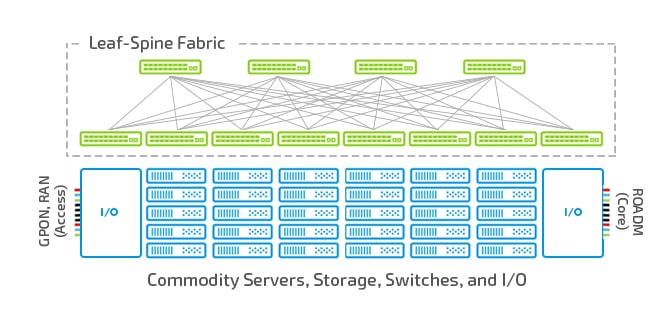
As for software building blocks, CORD utilizes the following open source projects:
- OpenStack [4] is a cloud operating system that provides the core infrastructure as a service (IaaS) capability and is responsible for management, control and provisioning of virtual machines and virtual networks.
- ONOS [5] is the network operating system that delivers highly scalable SDN control plane and enables agile service creation and deployment on any hardware. It is responsible for integrating virtual networks in the underlying fabric, which is accessed via OpenStack’s Neutron API.
- XOS [6] is a framework for operationalizing a collection of disaggregated components, which is implemented to standardize infrastructure services provided by OpenStack, control plane services provided by ONOS, and any cloud services running in virtual machines.
Re-architecting process
With regard to the described architecture, two steps should be taken to transform a service provider’s central office into CORD. The first one is disaggregation and virtualization of the purpose-built devices, that is turning each of them into its software counterpart. The second step is to provide a framework into which these disaggregated elements can be fitted, creating a consistent end-to-end system:
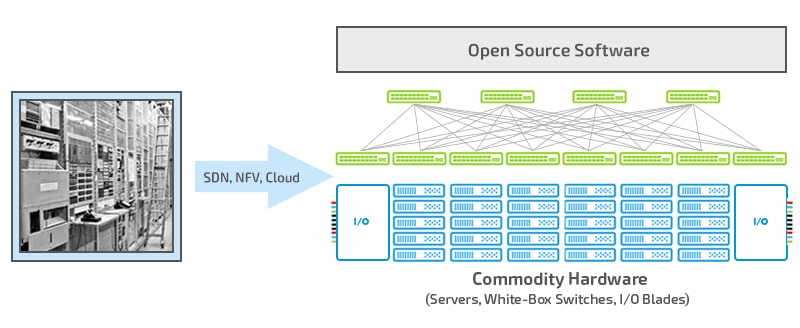
CORD applications
CORD is designed to be a general platform that can be configured for a wide range of deployment scenarios targeted at three main domains of use:
- Residential (R-CORD) is designed to provide services for residential subscribers connected over wireline technologies, such as content delivery networks (CDN), parental control and other services designed for customers in household sector.
- Mobile CORD (M-CORD) is the open reference solution for service-driven 5G architecture, featuring end-to-end open source slicing from programmable Radio Access Network (RAN) to disaggregated and virtualized Evolved Packet Core (EPC).
- Enterprise CORD (E-CORD) leverages open source software and commodity hardware to deliver enterprise connectivity services over wide area networks. With this configuration service providers can go far beyond simple connectivity services and support disruptive cloud-based enterprise services.
CORD software use cases
Creation of cloud-oriented wide area network. In 2015 AT&T started working towards the virtualization of its Gigabit Passive Optical Network (GPON). For that purpose, they cooperated with ON.Lab to look inside their proprietary boxes and discover how their functions could be broken down and handled by IT grade data center infrastructure [7]. In the course of this work, they discovered that OLT’s functions can be directly and relatively easily mapped to standard NFV infrastructure and publicly presented their achievements at the 2015 Open Networking Summit (ONS) in Santa Clara, CA.
Network slicing enablement. The upcoming 5G networks not only are intended to support increasing data rates, but also have to provide a common infrastructure to deliver new wireless services. To address these challenges, a 5G platform requires the ability to dynamically create programmable virtual networks and differentiated traffic treatment, allowing multiple logical networks to run on top of a shared physical network infrastructure, which is referred to as network slicing. Today’s Long-Term Evolution (LTE) networks do not support this feature, however, the M-CORD platform allows service providers to implement network slicing on the LTE network without having to wait for the 5G standards to be ratified.
Virtualization of mobile infrastructure. The next-generation CORD case, depicting M-CORD application to scale across multiple racks of servers using the CORD fabric, was demonstrated by the Open Networking Foundation in collaboration with Cavium, a leading provider of semiconductor products, at the 2017 Mobile World Congress in San Francisco. Cavium showcased a fully integrated M-CORD implementation of virtualized and disaggregated mobile infrastructure with edge services running on multiple racks of ARM based servers connected by CORD spine and leaf SDN fabric [8].
Is CORD the future of Telco industry?
CORD is certainly a major step on the path towards lowering costs and increasing agility of telecom central offices. By unifying NFV, SDN and the cloud, the CORD approach enables service providers to reduce CAPEX and OPEX, accelerate time-to-market for new services and features, as well as offer multiple ways to deploy virtual network functions. Even though the technology is quite fresh and is still in development, a significant number of telco companies are on their way to applying it in their switching facilities. And those who have not started to adopt it yet, will probably have no choice.
References
- 1. S&P Capital IQ: Market Intelligence
- 2. Digital McKinsey Insights: Reinvention through digital
- 3. Betting on Software-Defined Networking
- 4. OpenStack Official Website
- 5. ONOS Project Official Website
- 6. XOS Project Official Website
- 7. AT&T Testing Virtualized GPON
- 8. Cavium at Mobile World Congress
- 9. Virtual Subscriber Gateway (vSG)
- 10. Central Office Re‐architected as a Datacenter (CORD) White Paper
- 11. CORD Official Website



